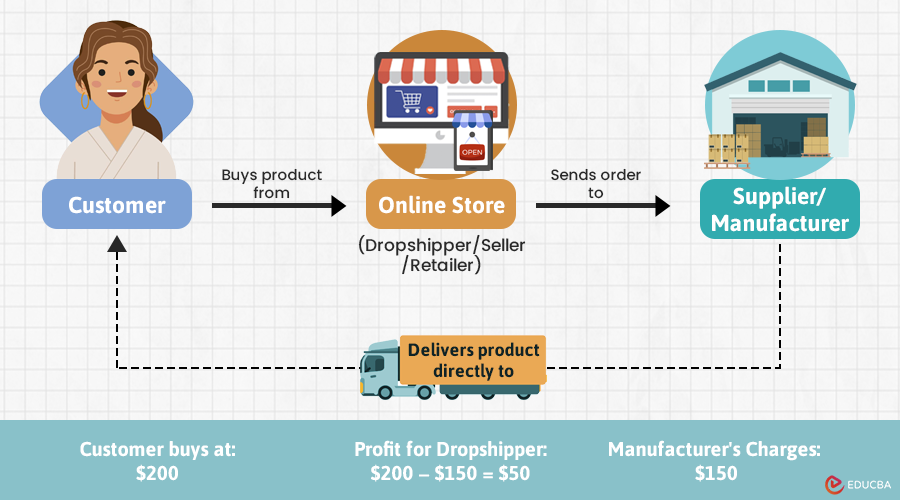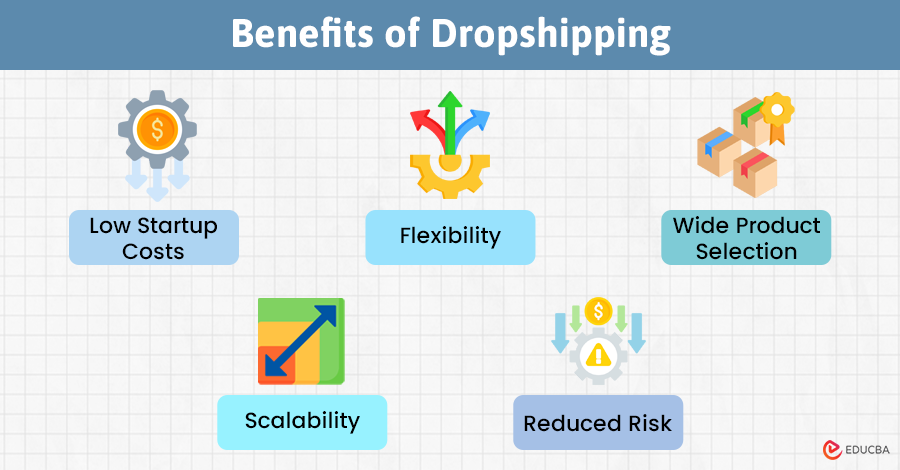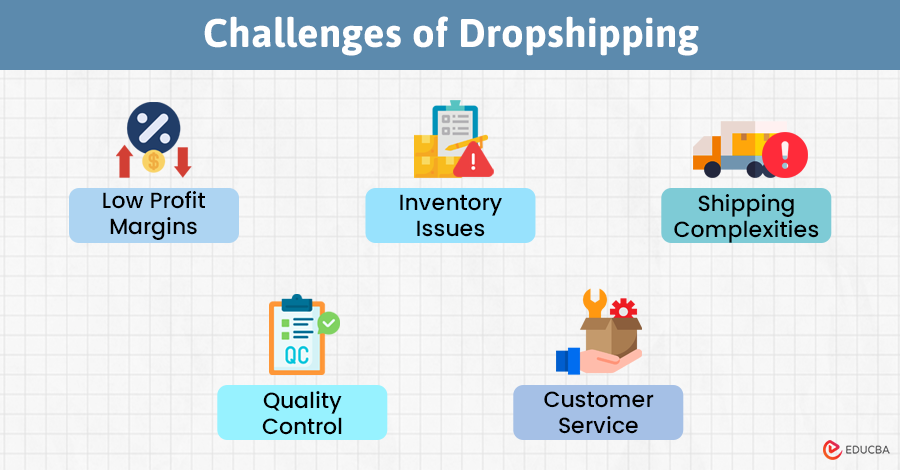What is Dropshipping?
Suppose you want to start a business selling a list of handy tools, but you do not want to handle the responsibility of buying and managing inventory, packing, and shipping products. In this case, you can start a dropshipping business.
In dropshipping, you set up an online store and list products for sale without keeping any inventory. When you get an order, you pass it on to a third party (supplier or manufacturer), who handles the packing, shipping, and delivery of the product.
In this business model, you do not need a physical store or warehouse; you only need an online platform to list the products. The main focus is marketing and selling instead of managing
Table of Contents
- Meaning
- Key Players
- Tools Required
- How it Works?
- How to Start?
- How to Select a Supplier?
- Benefits
- Challenges
- Trends in 2024
Key Players in Dropshipping
- Customer: Purchases the product from the retailer’s online store.
- Retailer (Dropshipper): Operates the online store, markets the products, and handles customer service.
- Supplier/Manufacturer: Keeps product inventory and sends the items to the customers on behalf of the retailer.
Tools Required
- E-commerce Platform: Provides the technology and tools for the retailer to set up and manage their online store (e.g., Shopify, Amazon).
- Payment Gateway: Facilitates secure online payments (e.g., PayPal, Stripe).
How Dropshipping Works?
1. Product Listing: The retailer lists products on their online store based on the supplier’s catalog.
2. Order Placement: The customer orders on the retailer’s online store. The retailer receives the payment and order details.
3. Order Forwarding: The retailer forwards the order and shipping details to the supplier.
4. Order Fulfillment: The supplier packages and ships the product directly to the customer.
5. Order Completion: The customer gets the product without knowing it came from the supplier.
How to Start Your Dropshipping Business in 8 Steps?
The steps to start your own dropshipping business are as follows:
Step #1. Decide Your Product Niche:
Select a market segment to target.
Consider factors like:
- Your interests and strengths
- Market trends
- Competition,
- Product demand
- Profit margins
Tips:
- Choose a niche that has consistent demand
- Use a product research tool to know what is trending in this domain
- Search for a niche with less competition
Step #2. Find Suppliers/Manufacturers:
Find suppliers that give quality products and reliable shipping.
How?:
- Use directories like AliExpress, Oberlo, SaleHoo, etc
- Check reviews and ratings
- Order samples to evaluate quality and shipping time
Tips:
- Maintain a good relationship with your suppliers
- Have backup suppliers.
Step #3. Build an Online Store:
Use an e-commerce platform to set up your online store.
Ensure that it is:
- User and mobile-friendly
- Visually appealing
- Has a domain name reflecting your brand identity.
Tips:
- Use high-quality images and detailed product descriptions.
- Include customer reviews and testimonials for credibility.
Step #4. List All Your Products:
Elaborately list all the products you want to sell.
Add:
- Clear and compelling product descriptions
- High-quality images and videos
- Product prices and offers.
Tips:
- Use SEO-friendly product titles and descriptions.
- Update product listings regularly.
Step #5. Set Up Payment Processing:
Integrate payment gateways to facilitate secure transactions.
Remember:
- Provide as many payment options as possible, like PayPal, Stripe, and credit card processors.
- Secure your payment processing
- Offer multiple currency options for international customers.
Tips:
- Keep transaction fees in mind when choosing payment processors.
Step #6. Promote Your Store:
Use digital marketing strategies to attract customers.
Check out these points:
- Optimize your store by using keywords.
- Use social media, email lists, blogs, and more.
- Consider paid ads
Tips:
- Run limited-time promotions to create urgency.
- Collaborate with influencers in your niche.
Step #7. Fulfill Orders:
To ensure timely fulfillment of your orders,
- Use tools to track orders and manage inventory.
- Regularly communicate with suppliers to ensure smooth order fulfillment.
Step #8. Provide Customer Service:
To maintain customer satisfaction,
- Offer multiple support channels: Email, live chat, phone, etc.
- Create a comprehensive FAQ section.
- Encourage customers to leave reviews and feedback.
Tips:
- Respond to customer inquiries promptly.
- Regularly update customers on their order status.
- Have a clear returns policy.
How to Select a Supplier for Your Dropshipping Business?
- Search reliable directories to identify potential suppliers.
- Check reviews and ratings on platforms and look for testimonials to evaluate supplier reliability.
- Buy product samples to assess its quality.
- Ensure the suppliers can handle inventory management and faster shipping, returns, and refunds.
- Analyze costs by comparing product prices, checking for hidden fees, and evaluating their shipping costs.
Benefits of Dropshipping
1. Low Startup Costs: No need for a physical store or inventory reduces initial investment.
2. Flexibility: Run your business from any location. All you need is an internet connection.
3. Wide Product Selection: Sell a range of products without keeping their stock.
4. Scalability: Easily add new products and reach new markets.
5. Reduced Risk: Lower financial risk as you only purchase products after a customer orders them.
Challenges of Dropshipping
1. Low Profit Margins: Intense competition can drive prices down, reducing profit margins.
2. Inventory Issues: Lack of control over inventory levels can lead to stockouts or overstock situations.
3. Shipping Complexities: Dealing with multiple suppliers can complicate shipping and lead to longer delivery times.
4. Quality Control: Limited ability to ensure product quality before it reaches the customer.
5. Customer Service: Handling returns, exchanges, and complaints can be challenging without direct control over the inventory.
Trends and Interesting Data on Dropshipping in 2024
By 2025, the global dropshipping market can reach $557.9 billion with a CAGR of 28.8%. Dropshippers are experiencing a growing demand for eco-friendly and sustainable products and an increase in mobile shopping. They are also using social media platforms for direct sales and customer engagement. Additionally, there is a rising use of AI and machine learning for personalized marketing and efficient inventory management.
Frequently Asked Questions (FAQs)
Q1. How profitable is dropshipping?
Answer: Dropshipping profit margins can range anywhere from 10% to 30%, but success depends on factors like product selection, marketing, and supplier relationships. However, profit margins are typically lower than traditional retail, so high sales volume is essential.
Q2. Is dropshipping legal?
Answer: Yes, dropshipping is legal. However, before you start, make sure you are aware of all national and state laws and comply with all relevant regulations.
Q3. Is it hard to learn dropshipping?
Answer: Learning to dropship is not hard but requires dedication and time. It can be challenging initially, but with the right resources and dedication, it becomes manageable. There are many resources available, including online courses, forums, and tutorials, to help you get started and succeed.
Q4. Can I start dropshipping for free?
Answer: Yes, it’s possible to start dropshipping for free. With the availability of many free AI tools and free trials for various websites and software, it is possible to start with $0. However, for a long-term and successful business, it’s advisable to invest in necessities such as a domain name, a reliable e-commerce platform, and marketing tools.
Essential tools include Shopify or WooCommerce for your store, Oberlo for product sourcing, and Canva for creating promotional graphics. Initial investments typically range from $50 to $300. It covers domain registration ($10-$15), a basic Shopify plan ($29/month), and some initial marketing expenses. Investing in these basics ensures a professional appearance, better functionality, and higher chances of success.
Q5. What are the best dropship products?
Answer: The best products are those that always stay in demand and offer good profit margins. Some examples are garments, baby products, pet supplies, phone accessories, etc.
Q6. Can I use multiple suppliers for my dropshipping store?
Answer: Yes, you can. It helps you diversify your product range and mitigate risks. However, ensure you have systems in place to handle order fulfillment efficiently.
Q7. How do I handle returns and refunds when dropshipping?
Answer: Follow these steps:
- Have a clear return policy
- Make sure your customers understand the process and have access to prompt resolutions.
- Handle returns by coordinating with your suppliers and providing customer support.
Recommended Articles
We hope this comprehensive dropshipping guide helps you start a successful business. Here are some other business-related guides you can read.



